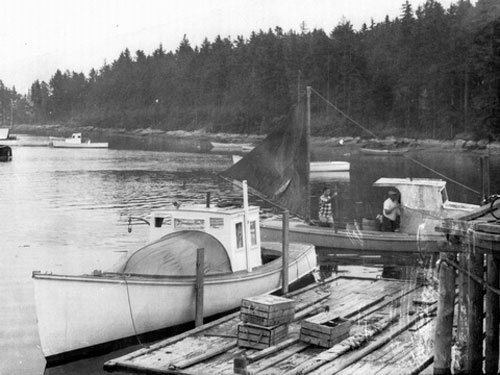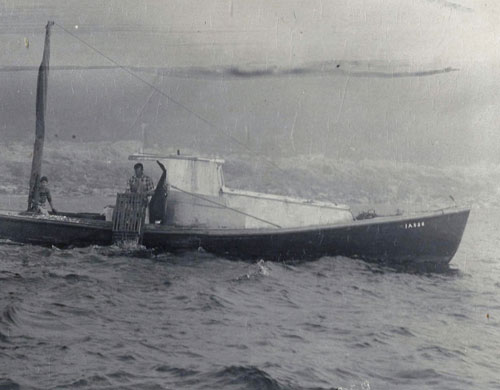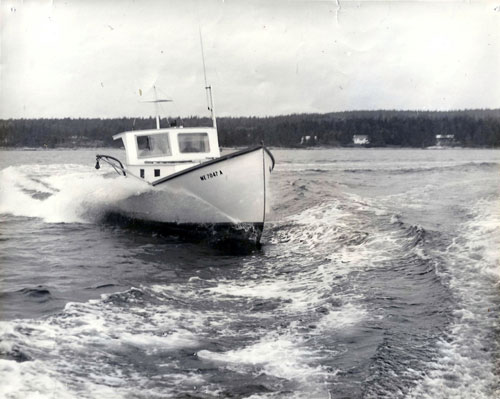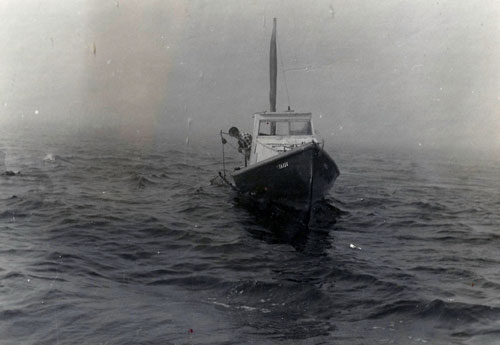LOBSTERING THEN AND NOW
continued from Home Page

Winter Harbor wharf 1940's. Charlie Jacob’s boat with spray hood and house added, left, and the then newer all-wood top, right background. Photo Courtesy of Winter Harbor Lobster Coop.
A few years later Blackmore’s grandfather went back to lobstering in a boat with a “not too dependable” motor. “If you knew the right swear words, you could get it going,” Blackmore said. “We learned the basics.”
Drafted in 1944, the year he graduated from high school, Blackmore ended up in Germany after the European armistice. He came home, went fishing with his brother, married, then tried quarrying, which he did not like. “I didn’t like working five days a week, 40 hours a week,” he said. “That’s not for me. I like to work as hard as I can work, earn as much as I’m capable of earning. That don’t happen when you’re working a regular job. That’s when I decided I was going to go lobster fishing.”
Blackmore fished lobster for almost 30 years. He had to stop at age 48 because, he said, “I was spending more time at the chiropractor’s than I could on the boat. I just couldn’t hack it. I couldn’t work as hard as I wanted to work. I had to do something else.”
That something else was running the Maine Lobstermen’s Association for seventeen years.
“That’s where all the fun started,” Blackmore said of the many battles he waged and won for fishermen, but that’s a story for another day.
Bob Williams, of Burnt Cove, was born the year Ed Blackmore started fishing, 1937. Williams started fishing the summer he graduated from high school: 1955. Because he did not come from a fishing family, Williams learned his trade by working as a sternman with Frank Libby.
“We probably would haul 125 to 175 traps a day,” Williams recalled, “and some days you didn’t get a lb. to a trap. In the best of the season: late in the fall, you’d get up to a couple [2] lbs.”
Back then, he said, there was a big market for crabs. He said a lot of people including himself went crab fishing. “You could get 15 to 20 crates of crabs a day,” he said, “and then you’d get some lobsters, which supplemented your income.” Since then that area that used to be rich in crabs: the one locals call the Western Bay, between North Haven, Vinalhaven, and Stonington, has become depleted.
“In those days,” Williams said, “you could close your traps up—there was no vent size—crabs were the major part of your income in spring for a lot of fellas in the bay. There were not many fishermen fishing winters then. They didn’t have the boats and things to go fishing with. There were a few people who fished outside where they do now.” There wouldn’t be more than a half dozen to a dozen fishermen out of Stonington, Williams said, because scalloping was a big fishery in the winter in that area. Others went clamming. Williams said, “There were no regulations.”
In 1959, Williams started fishing by himself. Asked how many species he fished, he replied, “In my lifetime I’ve trawled for halibut—there used to be quite a market for groundfish here—hake, pollack, cod. And we used to set trawls: long lines. And there was a big plant—two plants actually, at Vinalhaven—in the ‘60s. That’s what we done in the summer.
“There wasn’t many lobsters, so we took our traps up a lot of times and there wouldn’t be hardly any traps in the water in the summer. You didn’t get any shedders until almost September. “There’s always been some halibut caught in the spring and through the summer,” Williams continued. “Now, with the regulations,” he said, “I haven’t been for several years.”
Fishing crabs remained a primary fishery for a lot of people who fished that Western Bay and Blue Hill Bay. Williams said, “You could haul four traps and get a crate. If we caught 15 to 20 crates a day, that was average.”
Asked how much fishermen got for crabs, Williams replied, “They started out at 2 cents a lb. in the 1950s. Then it crept up. My son John did crabs in the 1970s, and he sold to Doug Hardy and got $10 a crate. That was 10 cents/lb.”

Doug Torrey hand hauling at Winter Harbor in the 1950's. Doug rebuilt the Elona after World War II. It’s design roots are in reach & sloop boats and early Frost racers. Photo Courtesy of Winter Harbor Lobster Coop.
Asked what lobster went for, Williams recalled fishermen going on strike in 1954 for 25 cents/lb. The price rose to 30 cents/lb. the year he started fishing, 1955. But Williams only fished lobster in the fall because, he said, “That was the only time there was any money in fishing.”
He said most of the larger fishermen would be seining or doing another fisheries. They wouldn’t set their traps until the first of September because there were no lobsters in June and July. “There was no shedders in the summer,” Williams said. “October and November were your biggest months in the bay.” He then stated, “The fishery has totally changed around.”
Indeed, a lobster fishery where traps in the waters between Stonington and Vinalhaven the summer and fall of 2012 often came up with from 4 to 11 lbs. per trap had changed. Though some thought the incredible numbers trapped might have been due to the number of baited traps on the bottom, often called open ocean farming. Then, again, water temperature had risen. That the fishery had changed was fact.
Oceanville lobster fisherman Frank Gotwals, who averaged 5 to 7 lbs./trap and 10 lbs. once during the summer and fall of 2012, started fishing in 1976 from an outboard. He recalled, “When I started, 1 lb./trap was considered really good fishing; 2 to 3 lbs. was pretty rare.” What’s more, he says, some of the places where he does well now, particularly in the fall months in deeper water, were not productive at all back in the ‘80s and were just hit or miss in the ‘90s. And he is far from the only fisherman who has experienced this shift in non-productive waters.
“If you caught a half lb. a trap for two weeks 34 years ago, you were a highliner,” recalled Leroy Bridges, of Sunshine Island. That was 1979, and the 32-foot boat Bridges started with at age 22 was, he said, “A 1957 Rich-built made in Bass Harbor. It had a 292 Chevrolet gas engine in it, and it was old.” That boat, built the year Bridges was born, cost the young fisherman $5,000.
In those days Bridges, like older fishermen, fished with a boxed compass and a watch. He added, “Raytheon made a Holiday Flasher.” It was the dinosaur of marine electronics. “The Holiday Flasher gave you no picture,” Bridges explained.” Based on the width of the red line, you could tell whether you were on hard bottom or soft bottom. When we left the cove, we would actually count the amount of shoals and you’d remember the depth of the water, so when you’d be headed home on your compass course, you could count those shoals from a known point, and you would know where you was in relationship to the cove. It’s a lot easier now,” he said. “Anybody can do it now.”
When Bridges was able to afford a Loran, he said, “We went from Loran A to Loran C. Then the improvement on C was Wass, which made it incredibly accurate locating your gear in the fog instead of barking your end buoys like we did in the good old days. And as for the boats themselves, Bridges said, “The boats we operate now are state of the art. They are better, bigger, faster and the electronics are far better. The electronics in my boat today cost $20,000 more than the first boat I ever bought.”
In 1979, when Bridges started, he said there two types of rope: floating and sinking. Crowe Rope, made in Warren, Maine, made both kinds and it made ragg rope, which was sinking rope. “Back then,” Bridges said, “rope didn’t last theoretically as long as it does now.” There are many more manufacturers now and there is a third type of rope, neutrally buoyant, or whale rope, which doesn’t hold up, but Bridges thinks it was not expected to.
Back then, he said, “There were wooden traps, and it cost $800 to $900 to build a hundred [of them].” He thinks wire traps were first used about five years after he started, around 1984. “They were called Marcraft,” he said. “They didn’t have any coating on them, and they didn’t work very well.” Although the Marcraft traps didn’t hold up well in storms, the old wooden ones didn’t hold up any better.
But Rhinocoat, traps with vinal-coating on the wire, held up pretty well, according to Bridges. And then came Aquamesh. There was a steady improvement of traps, Bridges said, and by now, there are all kinds of manufacturers of vinal-coated wire traps. They last so well, Bridges claims he still uses 15-year-old traps.

The Elizabeth in the late 1950’s, built by Junior Backman, Winter Harbor, ME. P
hoto Courtesy of Winter Harbor Lobster Coop.
He doesn’t remember what fuel cost in 1979, but he does know what he paid for bait: $3.50/bushel, and he earned $1.51/lb. for shedders that first summer he fished. In 1993, he paid $8/bushel for bait. On July 30, 1993, Bridges earned $2.53/lb. for shedders and $3.53/lb. for hard lobsters. In 2012 bait cost him $28/bushel. (During the hurricane a bait shortage caused a rise in price to $35/bushel.) November 16, 2012, Bridges said he earned $3.75/lb. for hard shells, but at the beginning of last summer, he said fishermen were being paid a low of $1.25/lb. at both the Stonington and Vinalhaven lobster co-ops. Prices fluctuated and on August 3rd, he earned $1.35/lb.
“There was so much angst,” Bridges said, “[The price] kept dropping daily.” He blamed the low price on the co-ops’ buyer and said, “The only saving grace was volume. And that shouldn’t have been the case. And unfortunately, not everybody had volume.” According to Bridges, the low price this year bred “animosity” toward every person and every thing fishermen could hold accountable for the low price.
In 1993, he paid $.88/gal. for fuel; on Nov. 16, 2012, he paid $3.81/gallon, and he earned $2.25/lb. for shedders.
“If you look at the low of last summer versus the 1993 price or the price 34 years ago at $1.51/lb., it’s just an absolute slap in every fisherman’s face.
“The expense is so much larger now. Back when I started, your insurance policy was a nice piece of change. I don’t know of many people who had boat insurance back then. Nobody was fishing with these multi-hundreds of thousands of dollar-priced vessels back then; there weren’t any. A thirty-six-foot boat was a big boat for lobstering. And if you had a diesel engine: well, [a friend], in Stonington, has a Detroit 453 in his boat; that’s probably the oldest engine around. It would be older than the length of time that I’ve been fishing [34 years]. It’s indestructible,” he said. “They just keep re-building them and putting them right back into service.
“They went from that to the Caterpillar naturally-aspirated [diesel engine]. It was a good one, but it was considered a throwaway because it would cost you more to rebuild it than to buy a new one. So there was a transitional period there.”
There is what is called a sleeved engine, Bridges said, explaining that marine mechanics can pull the sleeves out of the blocks and put in new ones and new pistons. Essentially, he said, “You’ve got a new engine, although you still have old blocks.”

The narrow beam of Doug Torrey's Elona off Winter Harbor in the early 1950's. At 37' x 7' the ratios were closer to that of a canoe than todays wide boats with big engines. Photo Courtesy of Winter Harbor Lobster Coop.
Back when Bridges started, an engine would cost a fisherman $10,000. Now they cost $50,000. The engine in Bridges’s boat, with its reverse gears, cost him around $50,000. On top of the cost of the engine itself, in order to have it installed, he said, “You can throw [in] another $10,000 to $20,000.”
The price of a boat with gear today as opposed to yesterday, Bridges said, is difficult to answer because of all the materials involved. He used running lights as an example and said fishermen used to be able to buy a set of two, one red and one green, for $25, or $12.50 apiece. Now each running light on Bridges’s boat—they’re LEDs, he said—costs $120. He has four.
“A light bulb,” he said—”They’re called Aquasignals—will cost you $27.” That’s just the price of the bulb itself. It doesn’t include the housing. Bridges said, “You used to be able to get them for a couple of bucks.
“A spotlight for your boat,” Bridges said. They were on sale at Hamilton Marine for $340 to 350. He said, “You used to be able to buy them for $75 to $100. It’s the same light.
Everything has gone up so darned much, which automatically brings you right back to the dismal price of lobsters.” And unfortunately, Bridges, who had just taken in his traps for the year, had a point when he said, “If the catch was, say, normal or down, it’s not worth the investment.”
Randy Johnson, Winter Harbor Coop, assisted with this story.
